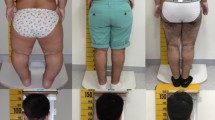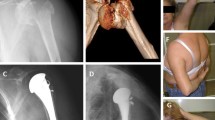Abstract
Purpose
Although humeral lengthening in patients with achondroplasia is an accepted procedure for improving functional status, there is still a paucity of information about the effectiveness of the method. Therefore, the aim of this study was to evaluate the efficacy and safety of humeral lengthening using monolateral fixators in patients with achondroplasia and unilateral shortening.
Methods
Twenty-one patients (31 humeri) were included in this study. The study group consisted of eight patients with achondroplasia (16 segments). The control group consisted of 13 patients with post-septic shortening of the humerus (15 segments). All subjects underwent distraction osteogenesis with the use of a monolateral fixator.
Results
The mean lengthening in the patients with achondroplasia was 8.29 cm, whereas in the control group it was 7.34 cm (p = 0.1677). The mean lengthening percentage in the patients with achondroplasia (50% of the initial length of the humerus) was significantly greater than in the control group (33% of the initial length of the humerus) (p = 0.0007). The mean healing index was 24.8 days/cm in the patients with achondroplasia and 28.56 days/cm in the control group (p = 0.1832). The overall complication rates for the achondroplastic and post-septic patients were, respectively, 175% and 160% (p = 0.1420).
Conclusions
Humeral lengthening with use of monolateral fixators in patients with achondroplasia is an efficient method. Although the segment lengthening percentage is significantly greater in patients with achondroplasia than in patients with post-septic shortening of the humerus, the safety of this procedure is comparable.





Similar content being viewed by others
References
Bellus GA, Hefferon TW, Ortiz de Luna RI, Hecht JT, Horton WA, Machado M, Kaitila I, McIntosh I, Francomano CA (1995) Achondroplasia is defined by recurrent G380R mutations of FGFR3. Am J Hum Genet 56:368–373
Balci HI, Kocaoglu M, Sen C, Eralp L, Batibay SG, Bilsel K (2015) Bilateral humeral lengthening in achondroplasia with unilateral external fixators: is it safe and does it improve daily life? Bone Joint J 97-B:1577–1581
Kim SJ, Agashe MV, Song SH, Choi HJ, Lee H, Song HR (2012) Comparison between upper and lower limb lengthening in patients with achondroplasia: a retrospective study. J Bone Joint Surg Br. 94(1):128–133
Pawar AY, McCoy TH Jr, Fragomen AT, Rozbruch SR (2013) Does humeral lengthening with a monolateral frame improve function? Clin Orthop Relat Res 471:277–283
Cattaneo R, Catagni MA, Guerreschi F (1993) Applications of the Ilizarov method in the humerus. Lengthenings and nonunions. Hand Clin 9:729–739
Kashiwagi N, Suzuki S, Seto Y, Futami T (2001) Bilateral humeral lengthening in achondroplasia. Clin Orthop Relat Res 391:251–257
Cattaneo R, Villa A, Catagni MA, Bell D (1990) Lengthening of the humerus using the Ilizarov technique. Description of the method and report of 43 cases. Clin Orthop Relat Res 250:117–124
Marangoz S, Herzenberg J, Paley D, Rovetta L, Standard S. (2010) Bilateral humeral lengthening in patients with achondroplasia. J Bone Joint Surg Br 92-B(SUPP IV):597.
McLawhorn AS, Sherman SL, Blyakher A, Widmann RF (2011) Humeral lengthening and deformity correction with the multiaxial correction system. J Pediatr Orthop B 20:111–116
Malot R, Park KW, Song SH, Kwon HN, Song HR (2013) Role of hybrid monolateral fixators in managing humeral length and deformity correction. Acta Orthop 84:280–285
Kato H, Minami A, Suenaga N, Iwasaki M, Kimura T (2002) Callotasis lengthening in patients with brachymetacarpia. J Pediatr Orthop 22:497–500
Akman SD, KarakaŞ P, Bozkir G (2006) The morphometric measurements of humerus segments. Turk J Med Sci 36:81–85
Paley D (1990) Problems obstacles and complications of limb lengthening by the Ilizarov technique. Clin Orthop Relat Res 250:81–104
Cattaneo R, Villa A, Catagni M, Tentori L (1988) Limb lengthening in achondroplasia by Ilizarov’s method. Int Orthop 12:173–179
Zinn SL (1990) Body size and habitus. In Walker HK, Hall WD, Hurst JW (eds.) Clinical methods: the history, physical, and laboratory examinations, 3rd edn. Butterworths, Boston
De Bastiani G, Aldegheri R, Renzi-Brivio L, Trivella G (1987) Limb lengthening by callus distraction (callotasis). J Pediatr Orthop 7:129–134
Tanaka K, Nakamura K, Matsushita T, Horinaka S, Kusaba I, Kurokawa T (1998) Callus formation in the humerus compared with the femur and tibia during limb lengthening. Arch Orthop Trauma Surg 117:262–264
Pietak A, Ma S, Beck CW, Stringer MD (2013) Fundamental ratios and logarithmic periodicity in human limb bones. J Anat 222:526–537
Yasui N, Kawabata H, Kojimoto H, Ohno H, Matsuda S, Araki N, Shimomura Y, Ochi T (1997) Lengthening of the lower limbs in patients with achondroplasia and hypochondroplasia. Clin Orthop Relat Res. 344:298–306
Paley D (1988) Current techniques of limb lengthening. J Pediatr Orthop 8:73–92
Kiss S, Pap K, Vízkelety T, Terebessy T, Balla M, Szoke G (2008) The humerus is the best place for bone lengthening. Int Orthop 32:385–388
Hosny GA (2005) Unilateral humeral lengthening in children and adolescents. J Pediatr Orthop B 14:439–443
Clement H, Pichler W, Tesch NP, Heidari N, Grechenig W (2010) Anatomical basis of the risk of radial nerve injury related to the technique of external fixation applied to the distal humerus. Surg Radiol Anat 32:221–224
Katz K, Goldberg I, Bahar A, Yosipovitch Z (1989) Humeral lengthening for septic neonatal growth arrest. J Hand Surg Am 14:903–907
Author information
Authors and Affiliations
Corresponding author
Rights and permissions
About this article
Cite this article
Shadi, M., Musielak, B., Koczewski, P. et al. Humeral lengthening in patients with achondroplasia and in patients with post-septic shortening: comparison of procedure efficiency and safety. International Orthopaedics (SICOT) 42, 419–426 (2018). https://doi.org/10.1007/s00264-017-3632-x
Received:
Accepted:
Published:
Issue Date:
DOI: https://doi.org/10.1007/s00264-017-3632-x




